Identifying and Recovering Troubled Projects: How to Rescue your Project From its Failure
Publications
Project Management Technology Magazine
Beijing – China – 2011
PMI Global Congress Asia Pacific
Hong Kong – China – 2007
Mundo PM Magazine
Curitiba – PR – Brazil – 2006
Abstract
The purpose of this article is to conceptualize and identify troubled projects and allow their evaluation and possible recovery, minimizing the impact of the negative effects in the event of a total failure. The word recovery, as used here, has a meaning that is different than usual. It does not mean leading the project to the intended success from the planning phase but to minimize total failure.
Currently there are lots of papers and studies on project management tools, methodologies, strategies, and processes. All these efforts are intended to enable and prepare project managers and their teams to ensure the success of their projects. BERRY (2002) complements this concept saying that virtually all the methodological patterns of projects are an important knowledge base on how to properly conduct a project, completing the work within its deadline, and with high-quality deliverables.
However, the reality that many project managers make evident is significantly different. In fact, even the most experienced project manager end up as acting as a “firemen” to their projects, trying at any cost to solve the problems and the difficulties found along the road.
These “Troubled Projects” are a reality in the worldwide business scenario; most of the times, dealing with a troubled project is a particularly challenging task for the project manager and his or her team. These projects require, for different reasons, specific attention and care.
Finally, the article deals with lessons learned with troubled projects and how to use them to avoid future problems.
Definition of Troubled Project
A troubled project can be defined as a project where the difference between what is expected and what has been accomplished exceeds the acceptable tolerance limits, pushing into a course that will inevitably lead to failure.
By assessing the nature of the projects, we can say that any project is characterized by a challenge, whether for its intrinsic complexity or its short deadline or low cost. To this regard, any project requires a level of control and management different from usual engagements, many times demanding a differentiated effort from the project manager and his/her team.
However, when the variances exceed an acceptable limit of tolerance we have a troubled project that requires a specific effort. In this case, a specific approach strategy becomes necessary, by defining a possible recovery or even deciding for an early termination.
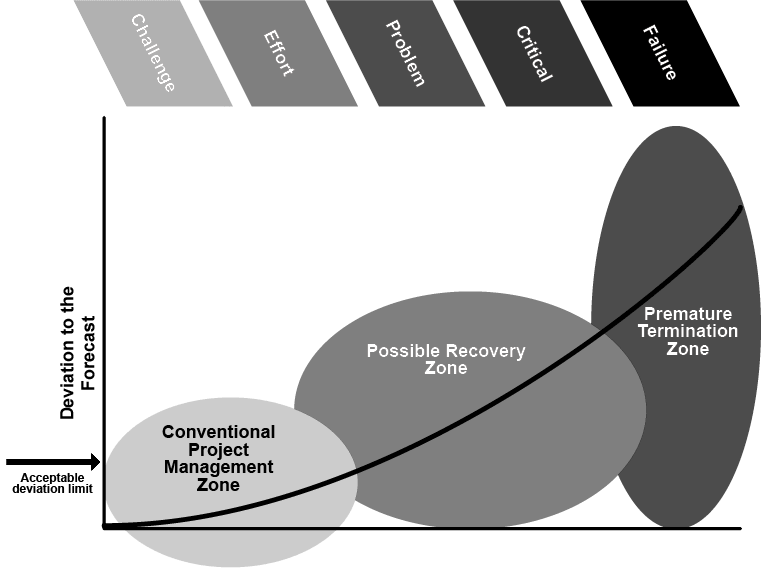
Exhibit 01 – Continuous sequence of troubled projects (ESI, 2005).
It is important to note that troubled projects are not failed projects. Failed projects are unrecoverable, since the highest level of loss possible has been reached. On the other hand, the troubled project has a possibility of being recovered although it shows strong indications that if it is not managed in a specific manner it can quickly deteriorate and become unfeasible.
When we use the term “recover”, what we mean is that there is a chance of recovery and not that the recovery is simple or easy. Exhibit 02 shows some of the erroneous perceptions regarding troubled projects.
 Exhibit 02 – Erroneous perceptions on troubled projects.
Exhibit 02 – Erroneous perceptions on troubled projects.
Identifying and Assessing a Troubled Project
A troubled project always presents indicative factors that might help recognize it as a problem. Some aspects related to stakeholders, project resources, documentation, and the triple constraint (scope, cost, and schedule) allow us to get a quick, direct perception of the problem degree the project is in, as shown in Exhibit 03.
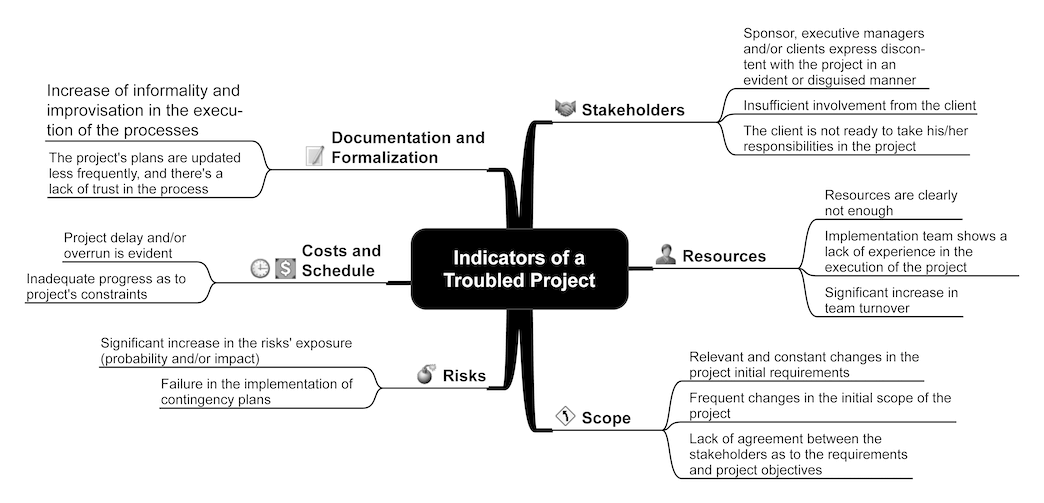 Exhibit 03 – Mindmap of the indicators of a troubled project. Based on SAROKIN (2005), WU (2000), and WARD (2003).
Exhibit 03 – Mindmap of the indicators of a troubled project. Based on SAROKIN (2005), WU (2000), and WARD (2003).
Although the aforementioned warnings are quite straightforward, it is important to highlight that none of them indicates that a project is an isolated problem. Most of the times, they operate together and indicate, in several ways, that there is a problem with the project.
In addition to the warnings listed before, a set of vital signs and qualitative assessment models can be built to develop a more accurate criterion on the real vitality of the project. KAMPUR (2001) says that the vital signs are measured by the variance between current status of the project and the values as planned, as shown in the example in Exhibit 04.
Vital Sign | Variance | Score |
Exhibit 04 – Example of vital signs models (KAMPUR, 2001). | ||
Percent variance between actual and planned schedule | < 10% | 0 |
10-20% | 1 | |
> 20% | 2 | |
Percent variance between actual and budgeted cost | < 10% | 0 |
10-20% | 1 | |
> 20% | 2 | |
Percentage of contractual deliverables completed on schedule | > 90% | 0 |
80-90% | 1 | |
< 80% | 2 | |
Percent variance between resources actually used and budgeted resources | < 10% | 0 |
10-15% | 2 | |
> 15% | 4 | |
Number of risk events with high probability and high impact | 1-3 Risks | 1 |
4-5 Risks | 3 | |
Above 6 Risks | 5 | |
ESI International (ESI, 2005) developed an assessment process of troubled projects based on a process of interviews, analysis and consolidation of results that allow us to assess the problem’s potential and the chances of recovering the project. The process is highlighted in Exhibit 05. In this process the participation of the main stakeholders and their personal perceptions are the key to the success of a possible recovery of the project.
 Exhibit 05 – Troubled project assessment model (ESI, 2005).
Exhibit 05 – Troubled project assessment model (ESI, 2005).
Several other models can be developed to identify scenarios in each organization. However, all these models should include a brief, quick, direct assessment; otherwise, when a project is identified as a problem it might be too late to recover it.
Project Recovery vs. Project Termination
Once the troubled project is assessed, we have to make the decision of aborting or recovering the project. Different factors may influence this process, but some basic considerations have to be observed. LONG (2003) proposes five key questions that should be considered to decide if the project will be recovered or aborted, as follows:
- 1. How important is the project for the sponsor, the stakeholders, and the organization?
- 2. Can the project continue as planned and defined or does it need to be completely redefined?
- 3. The organizational impacts and the resource needs for the recovery are feasible to produce the desired recovery?
- 4. Is there a need for political support so that the project can be recovered?
- 5. Are you (the project manager) personally motivated and interested to do what needs to be done to recover the project?
As a complement to the five previous questions, several factors can evidence that there is no chance of recovering the project. The most common factors are as follows:
- • Business benefit to be generated by the business cannot be delivered
- • The political environment is no longer sustainable
- • There is no longer a project sponsor and there is no apparent capacity to replace them
- • The business needs have changed
- • There have been significant changes in technology
- • Contractual or judicial dispute in progress that makes the project unfeasible
- • Market conditions have changed
If you decide to discontinue the project, its early termination can be carried out in two different ways, each with its own level of complexity, speed, and stress.
STEWART & SHEREMETA (2000) assessed the different drivers and impacts involved in the early termination of a project. They say that there are basically four ways to terminate a project, as follows:
- • Addition – Discontinue the project by adding the work to be performed and all its resources to a larger project.
- • Absorption – Discontinue the project having another project absorbing the work of the troubled project, without the resources and infrastructure accompanying the work.
- • Inanition – Discontinue the project by inanition (starvation), with the resources that sustain the project no longer being supplied, and the project being terminated due to complete lack of resources.
- • Extinction – Discontinue the project by extinguishing it, with an immediate cancellation action being taken, and the project ceasing to exist and only the work already completed and that can possibly be used is recovered.
In order to group all these concepts, we developed the flow chart in Exhibit 06, starting with the problem assessment up to the possible recovery strategies and the early termination of the project.
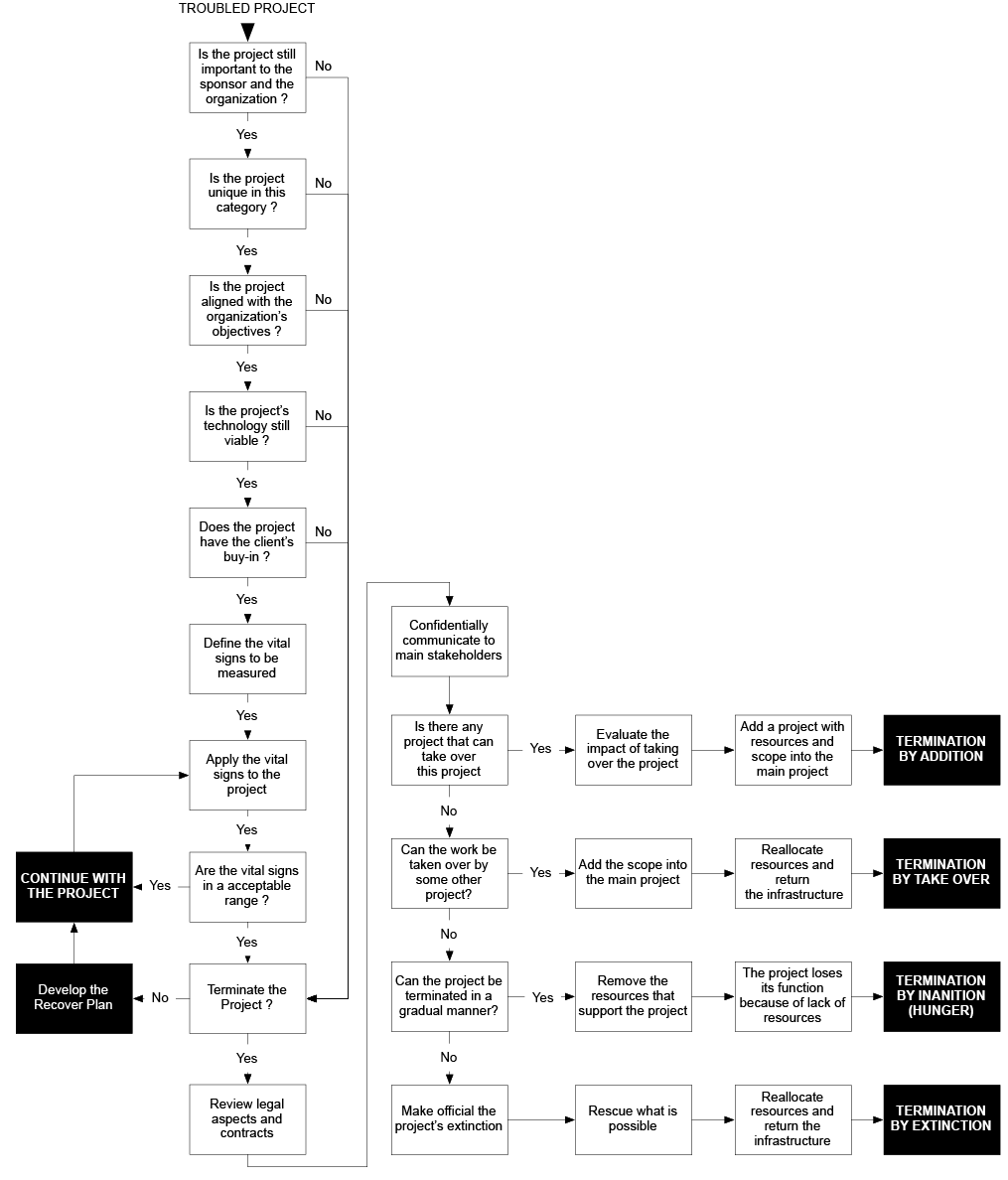 Exhibit 06 – Flow chart of the decision-making process identification regarding a troubled project.
Exhibit 06 – Flow chart of the decision-making process identification regarding a troubled project.
Regarding the decision on project recovery or termination, we should emphasize that there is no formula or quantification to suit all projects, in all organizations. Many times the search for the desired results can include the cancellation or anticipated termination of a project.
Developing the Recovery Plan
When a recovery strategy for a project is prepared, many say that it is not important to know what drove the project to its current status but rather to see what can be done and will be done to pull it out of that situation. However, this statement is incorrect. It is very hard to have a correct recovery strategy without knowing the facts that created the problem. Particularly, if the drivers are not eliminated, the project might be recovered in the short term, but with time it can fall back into the same critical stage it was before the recovery process.
Another important issue is that recovering a project is to save the loss and restore its usefulness, preventing the project’s total failure (ESI, 2005). Thus, when we intend to recover a project we are not discussing the full recovery of the project, but the avoidance of its total failure.
Basically, recovery consists of readjusting the basics of the scope, schedule, and costs and resources of the project, which is methodologically known as the project’s triple constraint, as shown in the project triangle in Exhibit 07.

Exhibit 07 – Project’s triple constraint (scope, schedule, and cost).
The proposals below can be discussed and assessed based on these constraints.
Option 1 – Reducing the project scope, maintaining the planned budget and schedule. This process can save parts of the project that may survive without full scope, as shown in Exhibit 08.
 Exhibit 08 – Project recovery by reducing scope.
Exhibit 08 – Project recovery by reducing scope.
Option 2 – Maintaining project scope, inflating project costs and maintaining the planned schedule. Usually this process is used when project scope cannot be reduced and the interest in results outweighs the shortfall caused by an increase in costs (Exhibit 09).
 Exhibit 09 – Project recovery by increasing available budget.
Exhibit 09 – Project recovery by increasing available budget.
Option 3 – Maintaining project scope by extending project deadlines and the budget forecast. Usually this is used when schedule is not essentially critical for the project, where a slowdown may avoid an increase in cost, thus allowing us to maintain the scope (Exhibit 10).
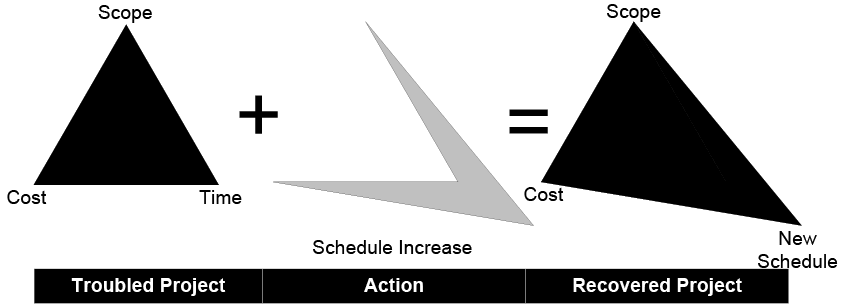 Exhibit 10 – Project recovery by extending schedules.
Exhibit 10 – Project recovery by extending schedules.
Option 4 – The project is totally redefined, thus creating a new relationship between scope, schedule, and cost, with only portions of the original projects scope. Usually this is used when options 1 to 3 are not considered as appropriate (Exhibit 11).
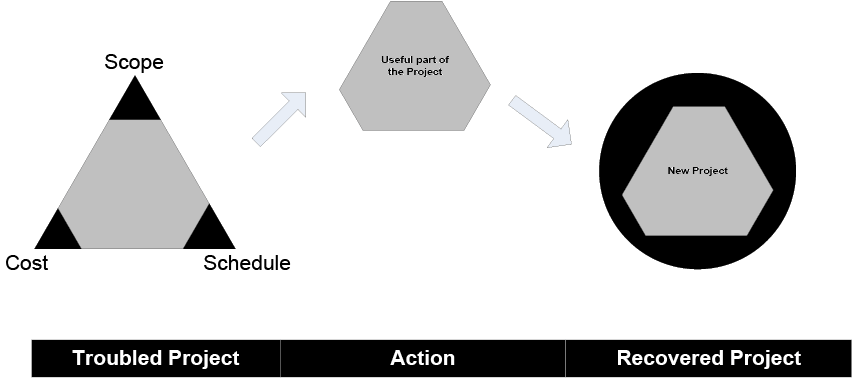 Exhibit 11 – Full redefinition of the project, using part of the results obtained.
Exhibit 11 – Full redefinition of the project, using part of the results obtained.
The four options shown above are the foundations for any type of recovery. All other types and solutions proposed are but variations resulting from one of these options.
In addition to this resizing of the triple constraint, several other actions should be taken to ensure that the recovery attains the expected success. In these cases, it is necessary not only an radical change in planning or in project requirements, but also a radical change in the behavior of the people. LONG (2003) mentions various actions that the project manager and the team should take to ensure the success of the recovery plan, as follows:
- • Restructure the project team and/or increase the controls over the work.
- • Politically consolidate the project with its sponsor, company executives, and stakeholders, searching for broad, unrestricted support.
- • Create a solid communication program with a positive message in connection with the changes.
- • Conduct and maintain an optimistic attitude and environment and, hoping for success.
- • Ensure the personal commitment to assure the success of the recovery strategy.
Recovery Plan Success Factors and Lessons Learned
When conducting the assessment of the troubled project and its possible recovery it is possible to say that some of the lessons learned need to be presented again:
- • Always prioritize. There is never time or money to solve all problems.
- • Be aggressive. Look for the problem and find the solutions.
- • Proactivity. Do not wait for problems to be solved on their own.
- • Establish accountability lines. Know who is responsible for what within the project.
- • Worship experience. The authority to make decisions should be transferred to the most experienced person and not necessarily to the highest hierarchical position.
- • Find the problems. Try to identify the problems in a structured way and as a team, thus avoiding that the project be found due to its problems.
- • Do not micromanage. Details prevent the whole from being easily identified.
- • The real problem may not be evident. It is not always that what needs to be solved is what is more apparent in the project. Check what is behind the curtains.
- • Look for and assess the impacts.
- • Never miss opportunities. An opportunity lost can be one of the biggest problems for the project.
- • Poor decisions hurt. Making a wrong decision is as harmful for the project as not deciding at all.
- • Contextualize opinions. Outside opinions need to be inside a context and must be integrated.
Finally, it is important to break the cycle that created the problem. You should always remember the rules of Newton’s Law. This law states that objects in motion tend to stay in motion unless an outside force opposes them.
Conclusions
Preventing a project from becoming a challenge requires proactive action. First of all, recognizing that a problem exists is itself already a problem. The article “Why Bad Projects Are So Hard to Kill”, published by Isabelle Royer in the Harvard Business Review in 2003 (ROYER, 2003) has, in its own title, the search for more answers on the difficulty to assess and solve problems. She says that this is due to an unconditional belief that the project, even when going through stages of complete chaos, will overcome the obstacles and be a success in the future. This perception is contagious; everyone ends up believing that in the future a “miracle” might occur and transform the project in a huge success.
Unfortunately, reality always proves to be the opposite of a “miracle”. If we look again figure 1, we will note that when the ones involved really accept that there is a problem, then the problem no longer exists. Now, it is a failure.
Therefore, when are faced with a troubled project, the first thing to do is to accept that there is a problem and quickly identify its magnitude, and the actions that should be immediately taken.
In a project this close to danger, any day lost is a day that will never be recover.
References
BERRY, D. (2002). Your Project is in Trouble! Now What? San Antonio: Project Management Institute Global Congress United States.
ESI International. (2005). Rapid Assessment and Recovery of Troubled Projects. Arlington: ESI International.
HARVEY, J. B. (1996). The Abilene Paradox and Other Meditations on Management. New York: Jossey-Bass.
KAMPUR, G. K. (2001). How to Kill a Troubled Project. San Ramon: Center for Project Management.
LONG, S. P. (2003). Succeeding With Troubled Projects. Baltimore: Project Management Institute Global Congress 2003.
ROYER, I. (2003). Why Bad Projects Are So Hard to Kill. Boston: Harvard Business Review.
SAROKIN, M. (2005). 10 Indicators of a Troubled Project. EDS Next Big Thing Blog.
STEWART, W. M. & SHEREMETA, P. W. (2000). Will You Be Terminated Today. Houston: Project Management Institute Global Congress 2000.
VARGAS, R. V. (2004). Using Earned Value Management Indexes as a Team Development Factor and a Compensation Tool. Prague: Project Management Institute Global Congress EMEA.
WARD, J. L. (2003). There is a Signpost Up Ahead! Recognizing and Dealing with Project Warning Signs. Baltimore: PMI Global Congress North America 2003.
WU, J. (2000). Business Intelligence: Top 10 Warning Signs of a Troubled BI Project. DM Review Online website (www.dmreview.com).
Troubled Projects , Failure , Project Success